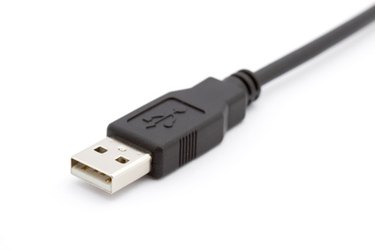
Universal Serial Bus (USB) ports are rectangular slots normally found near other plug ports on your computer. USB was introduced as a fast way to transfer data among devices, while high speed USB, also known as USB 2.0, was released in 2000. USB 2.0 ports are backward compatible, since they are pre-installed with drivers for USB 1.0 and 1.1. However, your transfer speed will be limited by the speed of the USB port, so checking that you have high-speed USB ports is a good way to ensure fast data transfer.
Step 1
Locate your USB ports by looking for the rectangular slots on the side of your laptop or the back of your desktop. You can recognize the USB symbol, which looks like a sideways "Y" or trident shape.
Video of the Day
Step 2
Click on the "Start" button or the Microsoft icon on your desktop to open the Start Menu. Select "Control Panel" and then "Device Manager." Device Manager is also accessible in older versions of Windows by clicking on "System Properties" in the Control Panel, then finding "Device Manager" in the Hardware tab of the System Properties dialog box.
Step 3
Locate your Universal Serial Bus (USB) controllers group of devices, located toward the bottom of the list. Clicking on the arrow will expand to show you the list of USB controllers and devices connected to your computer.
Step 4
Check the list of USB Controllers for the word "Enhanced," which will indicate high-speed functionality. Don't be alarmed if you see another standard controller, as this indicates the backward compatibility of your device with older USB speeds.
Step 5
Plug a known high-speed USB device into your computer and transfer data. USB 1.1 was limited to 12 Mbps transfer rate, while USB 2.0 is 40 times faster. In a high-speed USB port, your files should transfer around 40 megabytes per second.
Video of the Day